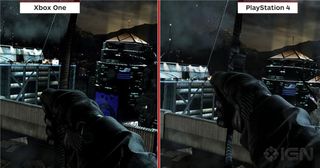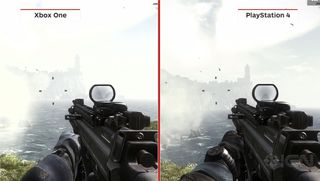PS4 Vs Xbox One: See How Resolution Affects Draw Distance, Visibility, Gameplay

IGN released an updated comparison video of Call of Duty: Ghosts for the Xbox One and PlayStation 4, following the “Resolutiongate” fiasco where Infinity Ward released 720p versions of Call of Duty: Ghosts for the PlayStation 4 and Xbox One, even though the game was supposed to be native 1080p for the PS4. The results are not even debatable.
IGN apologized for the skewed results that occurred in the original comparisons, due to some tampering by Infinity Ward, which could have been done to ease the benchmark results ahead of the embargos set in place for Call of Duty: Ghosts. Honest comparison could have easily swayed people to realize that the game's resolution is more than twice the pixel density on the PS4 compared to the Xbox One. Nevertheless, admissions from IGN and Infinity Ward about this Resolutiongate mess only furthers momentum behind conspiracy theories, and many of them don't look half wrong in light of this information.
Moreover, we recently did an article noting that resolution discrepancies in games can and do affect gameplay, this is corroborated by indisputable evidence featured in the 1080p video above, and the untouched screenshots below, in which you can readily and easily see the difference in resolution.

So you want to ignore the jaggies? Fine, brush it off that it's not that important in the screenshot above. Take into account that the resolution differences really come into play later in the video. Check out the 1080p photo comparison below...

Admittedly, this game looks terrible on both new-gen consoles... heck it looks terrible on high-end PCs, too.
Anyway, the aliasing is still present even with the PS4's 1080p resolution. Nevertheless, you can easily see that in the Xbox One shot to the left, many of the objects in the immediate distance on the roof are so jaggie due to the lower resolution that you can't readily tell what you're looking at. The stark use of a differentiated contrast seems to help a little, and there's a bit of sharpening going on, which in my opinion, actually makes the game look worse. Still, if you look at the office buildings you'll see that some of the objects are so muddied and blurry due to the rough edges that they require a bit of strain to ensure that you're looking at what you think you're looking at.
CINEMABLEND NEWSLETTER
Your Daily Blend of Entertainment News
On the opposite side with the PS4: while the graphics are nothing to write home about, the objects are at least visible enough that you can make out the entities and objects scattered throughout the office environment, even at a distance.
In the shot preceding the one above, if there was a guy you had to snipe from that distance on the building across from you, you could barely make him out amongst the environmental objects due to all the terrible aliasing on the Xbox One's side. I can now see why the benchmarks were fixed in favor of the Xbox One.

However, some of you might think all of the above is circumstantially inadmissible to the resolution debate because it's just a few screenshots showing jaggies. Take an honest look at one of the more nefarious offenders of the bunch, with this last shot here...

As you can see, the Xbox One makes greater use of bloom and fog to purposefully hide and distort the viewscape in order to cover for the draw distance and visibility limitations. As mentioned in our other article, this does affect sniping; this does affect whether or not you can spot enemies for your teamamtes; this will affect gameplay.
Keep in mind, also, you're seeing this rather noticeable difference with a poorly optimized game. Imagine when the developers start iterating to the metal?
I at least have to give props to IGN for coming clean about this issue, but it's too little, too late. Majority of people have already made their decision based on misrepresented data.
On the upside, so long as gaming media at least keeps it honest and lets people know about these issues up front and before the games actually release, it may not bee too bad on the end-user with discerning tastes in performance and playability.
It's obvious, though, this gen will be PS4, Xbox One and Wii U in order of graphical output, and so long as media makes it known that Xbox owners will be getting the graphically inferior version of many multiplatform titles this time around, it may eventually compensate for the media's poor display of downplaying the reality of the hardware discrepancies between the Xbox One and PS4.
Also, don't expect this gap to shorten as both systems continue to receive software and firmware optimizations. But remember: Optimization has scalable ceilings for certain features, but hardware output is finite. You cannot escape the limitations of hardware.
Staff Writer at CinemaBlend.

After Lopez Vs. Lopez Delivered In-Law Shenanigans, Vicki Lawrence And Stephen Tobolowsky Weigh In On Their Futures On George Lopez's NBC Sitcom

Ridley Scott Is Working On A New Alien Movie, And As A Fan, I'm Chestbursting With Excitement

Not Only Did Moana 2 Filmmakers Listen To Cries For More Pua, They Also Got Me More Excited About The Adorable Pig’s Role In The Sequel
Most Popular




